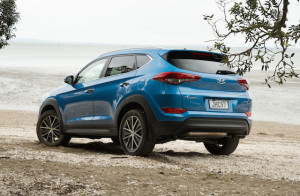
Hyundai design chief Thomas Burkle has said that car design is about getting the right proportions inside and out. “It’s not just the shape, the overall balance comes from the proportions,” he said. “Developing the package is the challenge, from the interior to the wheelbase.”

Easy to see, then, why Burkle rates the all-new Tucson SUV as one of his most satisfying projects. The standout design feature is all about proportions, how the 54-year-old German stylist – 10 years as head of Hyundai design – has made a bigger car still look somewhat compact.
He and his team reinvented the Tucson from the outside in and the inside out. The project began with the boardroom brief: “We want this car to make people think a little differently about Hyundai.” In doing so Burkle has surely influenced future SUV designs from rival carmakers, such is the freshness, scope and simplicity of his work.
The third-generation Tucson revives the badge after the 2004 original lost it to the second-generation ix35 in 2009. Hyundai wanted to bring back the name to fit with its bigger SUV, the Santa Fe. Both names link the storied south-western USA states of Arizona and New Mexico.
Hyundai NZ general manager Andy Sinclair is happy the Tucson name is back, too. Not that the ix35 moniker has handicapped sales; indeed it is has been the best selling compact SUV in NZ for some time. It is still selling well on runout, helped by wiggle room on the price, of course.

It’s just a naming thing for Sinclair. “Some buyers still have the original Tucson – I hope the new name will get customers into the new car,” he said.
The classy-looking Tucson Mk III is 65mm longer, 25mm wider, 5mm higher, has a 30mm-longer wheelbase and a wider front and rear track than the outgoing ix35, exterior dimensions that helped Burkle dial in a generous amount of interior room for both front- and rear-seat occupants.
The cabin is a conservative layout, blending good quality materials with clear instruments and a touchscreen multimedia system at the top of the centre console. It’s a simple, functional, no-fuss environment.
Tucson is soon to be the first vehicle in NZ to get computer giant Apple’s CarPlay system, which brings with it all the benefits of Apple’s world of infotainment. Early next year, Google’s Android Auto system will also be available.

As much as the look of the Tucson has changed, so has the driving experience. Like other Hyundais in this part of the world, Tucson’s suspension set-up has been individually tailored to cope with a mix of road surfaces. It’s an evaluation process – finding out which combinations of shock absorbers, springs and anti-roll bars best aid driving dynamics.
Hyundai NZ launched the new model between Hawkes Bay and Taupo, over a few hundred kilometres on good and bad sealed surfaces, gnarled metal roads, farmland tracks … and it might be that Tucson is running Hyundai’s best-sorted suspension set-up yet. Time will tell.
The ride and handling package in each model – 2WD and 4WD – showed why the carmaker has placed so much emphasis on suspension tuning. Each variant showed pretty much the same behaviour: great comfort on all surfaces, accurate steering with plenty of feedback from the front tyres, and a stability and agility when pushed that puts it at the top of its SUV segment, no question.
There are nine Tucson variants, three 2WD and six 4WD, priced between $39,990 and $63,990. Three Euro5-rated engines are available: 2.0-litre petrol delivering 121kW/203Nm and limited to the three front-drive models. The 4WDs get either a 1.6-litre turbo petrol generating 130kW/265Nm, or 2.0-litre diesel with 136kW/400Nm.
The 2.0-litre petrol and diesel engines are mated to six-speed manual or six-speed auto ‘boxes; the 1.6-litre boosted petrol (the detuned Veloster engine) gets a seven-speed dual-clutch automatic. Hyundai claims town-and-around fuel figures of just under 8 litres/100km for the 2.0-litre petrol variants; 7 litres for the 1.6-litre boosted petrol; and 6.8 litres for the 2.0-litre diesel.
